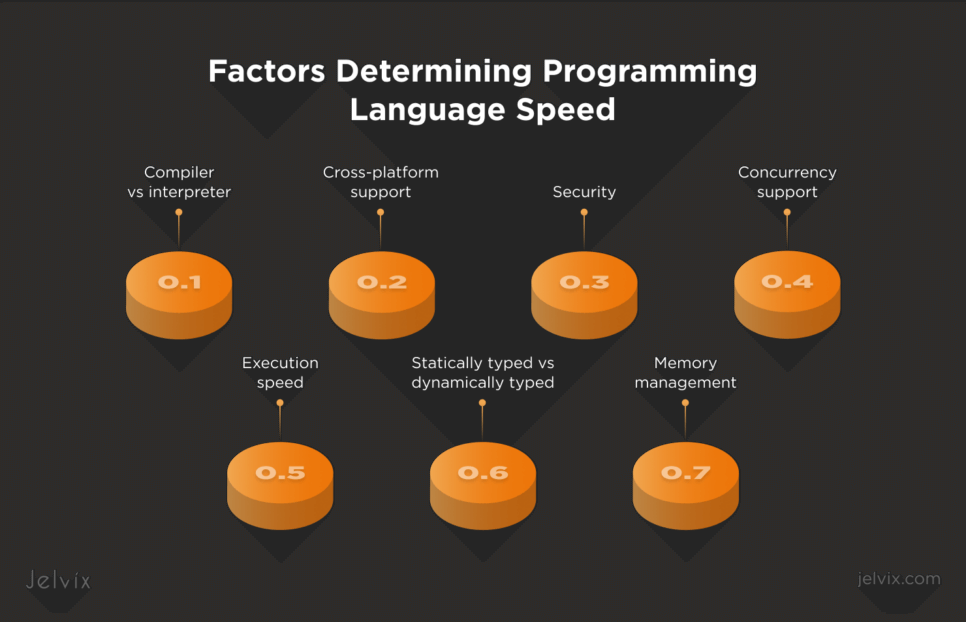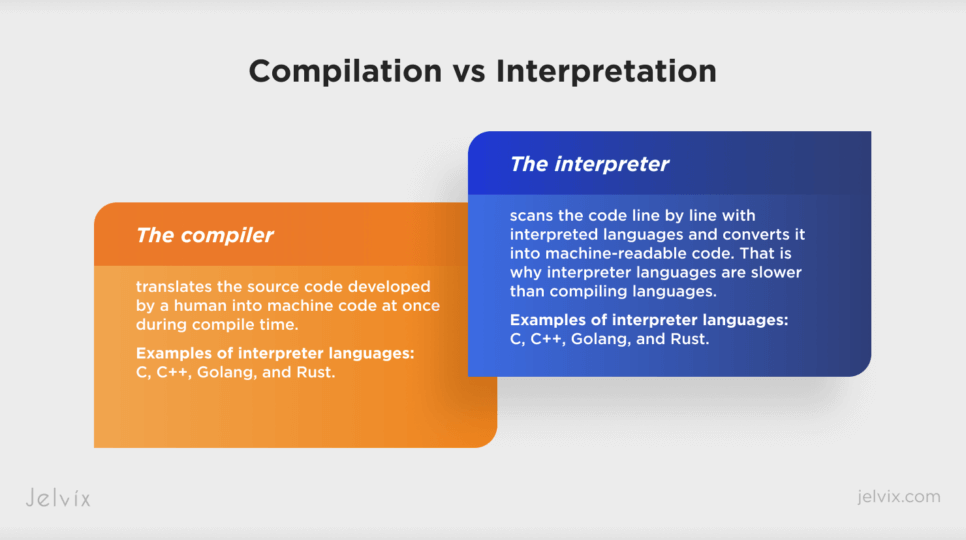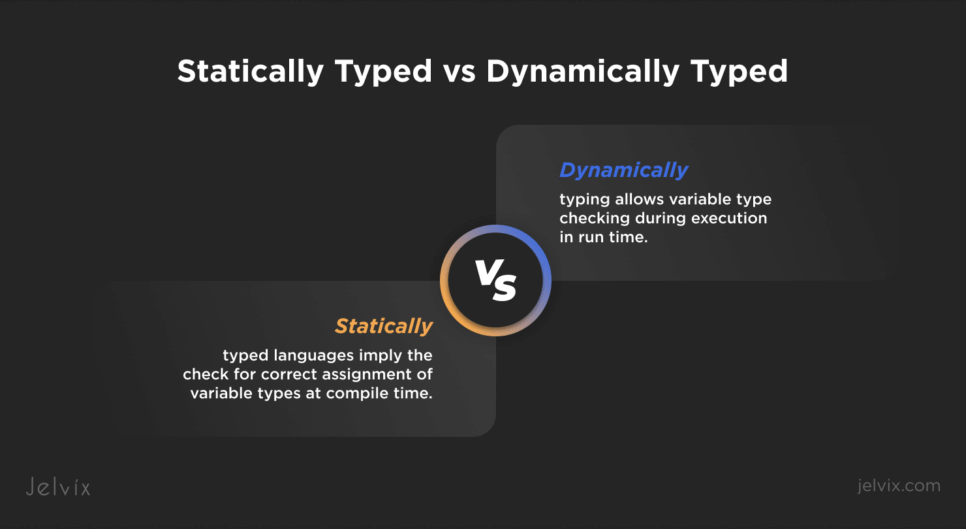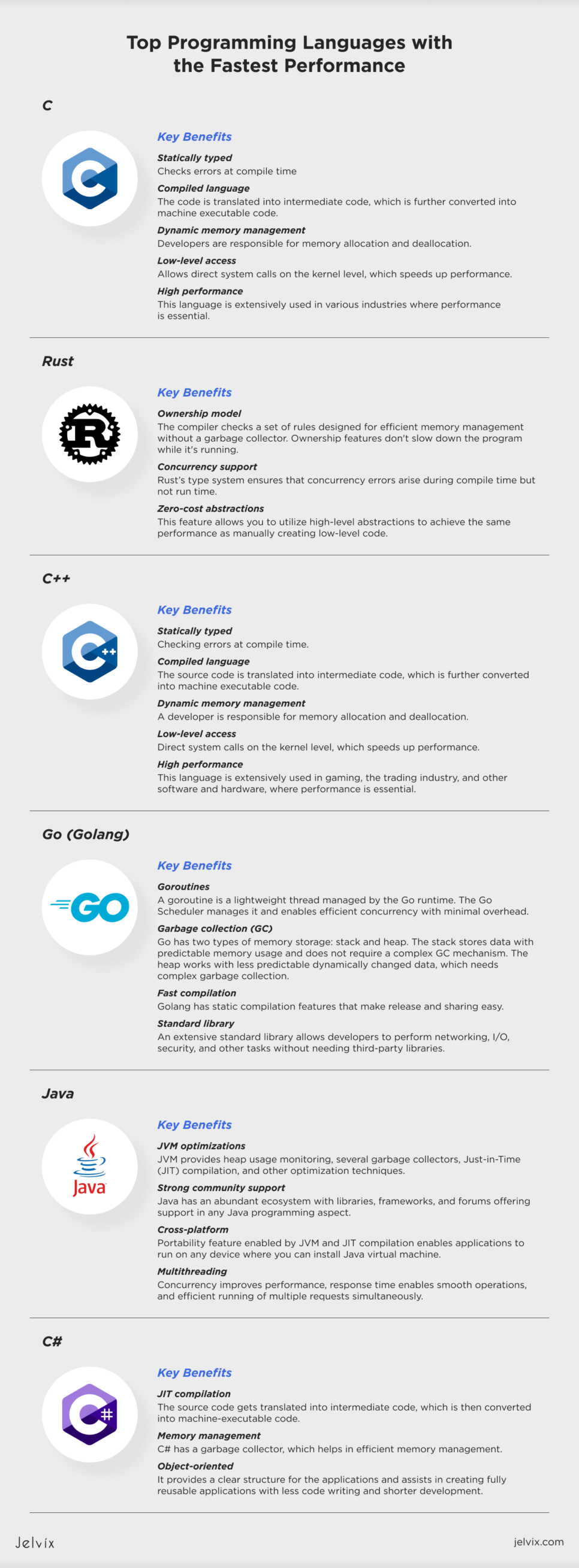Speed has become a critical factor of success for a programming language. The amount of data is snowballing every year. Global data creation is expected to reach 180 zettabytes by 2025. So, fast data processing is vital for the seamless performance of applications. Complex data computing and concurrency support also require high performance.
But what is the most efficient language? Speed is not the only factor defining the right programming language for software development. Code readability and maintenance, community support, and other factors are vital for coding. However, how fast an application runs is essential for its overall performance.
What determines the speed of programming language? Learn about factors that impact language’s speed in the next section.
Factors Determining Programming Language Speed
Hundreds of existing software development languages offer users different development possibilities and execution speeds. Speed is not the single metric determining the usefulness of the software development language you choose. Developers consider other factors. Some languages may be slower than others, but the software development process with them can be robust, much more accessible, less expensive, and time-consuming.
Some programming languages may be used for tasks requiring slightly lower execution, i.e., security-critical tasks. However, software development language speed still favors scientific computing, extensive data analysis, and other tasks. So, let’s analyze what impacts language speed to understand why one software language is faster than another.
Programming language speed depends on various factors.
- Compiler vs interpreter;
- Cross-platform support;
- Statically typed vs dynamically typed;
- Security;
- Concurrency support;
- Execution speed;
- Memory management.
Compilation vs Interpretation
Compiled languages such as C, C++, Golang, and Rust perform faster than interpreted languages such as Python, JavaScript, and Ruby.
The compiler translates the source code developed by a human into machine code at once during compile time. The interpreter scans the code line by line with interpreted languages and converts it into machine-readable code. That is why interpreter languages are slower than compiling languages; they require more time for code execution. The compiling process allows the conversion of all high-level language codes into intermediate codes at once. The PC executes this code much faster than the interpreters.
Today, the separation into compiled and interpreted languages is slightly outdated. Developers name truly compiled languages into machine code as AOT compiled (Ahead-of-Time compiled) to distinguish from JIT compilation (Just-in-Time compilation). C, C++, and Rust are examples of AOT languages. JavaScript and Java have JIT compilers. This means that the code will be interpreted at runtime, but after some time, more active code fragments will be compiled by the Just-in-Time compiler.
Cross-platform Support
Some portable languages, like C# and Java, allow execution on different operating systems. So, the source code undergoes both compilation and interpretation processes. There is another approach of cross-platform support, which is supported by languages such as Rust and Golang. They can be compiled for different platforms using AOT compilation, while Java/C# first languages are compiled into bytecode, which will run on the target machine.
Cross-platform capabilities mean this code should be converted into bytecode, which is then run in virtual machine runtimes. In such cases, the speed will be compromised, making the cross-platform languages slower than those without such ability. On the contrary, cross-platform languages with JIT-compilation support can outperform compiled languages such as C++ and Rust in the long run. Server apps run for days, months, and even years, for example, because JIT compilation considers a machine and machine architecture under the code. They can generate high-performance and optimized machine code, which is often impossible in the AOT-compilation stage.
Statically Typed vs Dynamically Typed
Statically typed languages imply the check for correct assignment of variable types at compile time. The user will see an error message at compile time if the same variable is initialized many times with several data types. Variable type checks are done during run time with dynamically typed languages. Static typing check requires type checking at compile time before run time execution. Dynamically typing allows variable type checking during execution in run time.
Programming Language Levels
Language level also influences speed. Developers usually highlight low-level programming languages and high-level programming languages. The difference between them is as follows.
Each statement of low-level language corresponds to a single instruction for the machine, while each statement of high-level language can result in multiple instructions for the computer.
Low-level programming languages, e.g., Assembly Language and Machine Code, are easy for computers to process but hard for humans to read. High-level programming languages, i.e., Java, C#, and JavaScript, are more accessible for people to comprehend. However, the source code needs to be compiled or interpreted before the machine can execute it. Therefore, low-level languages are faster than high-level languages.
Multithreading Support
Multithreading capabilities in software languages imply that a task or program can be divided into a few different functions to run simultaneously. Programming languages that support such a feature allow much faster application execution. Concurrency is helpful for programs that calculate large data sets or analyze big chunks of data. Such software can use several cores at the same time to ensure faster performance but sometimes requires more CPU usage.
Memory Management
Programming languages that use garbage collection features designed for efficient memory management are slower than those like C++ that don’t. Despite the compromised speed, developers have fewer headaches while creating applications.
Again, the language’s speed is not an ultimate factor that impacts decisions regarding the choice of a specific software development language for certain developing tasks. You should include other factors in your analysis. However, if you are looking for the fastest programming language for lightning-speed application performance, here are the top six software development languages that may suit your needs.
Top 6 Fastest Programming Languages
1. C
Overview:
Developers consider C one of the fastest programming languages for low-level development. C is an excellent choice for low-level applications, while C++ is a good fit for enterprise software. C and C++ have similar syntax, but C++, as a subset of C, obtains a broader functionality. Usage of C matters for high-performance critical applications: operating systems development, graphical user interface (GUI), browser engines, embedded systems, and other use cases.
Key Features:
- Statically typed: Checks errors at compile time;
- Compiled language: The code is translated into intermediate code, which is further converted into machine executable code;
- Dynamic memory management: Developers are responsible for memory allocation and deallocation;
- Low-level access: Allows direct system calls on the kernel level, which speeds up performance;
- High performance: This language is extensively used in various industries where performance is essential. C runs faster than C++.
Use Cases:
- Low-level development;
- High-performance servers;
- Game applications;
- Financial industry;
- Scientific computing;
- Real-time applications.
2. C++
Overview:
C++ is a well-known extension of the C programming language, designed by Bjarne Stroustrup, a Danish computer scientist, in 1985. He decided to add support for object-oriented programming to this language.
C++ is a general-purpose, object-oriented, system-level programming language. It is compiled and statically typed and is widely used for performance-critical and system-level applications.
Developers must specify variable-type declarations. The statically typed capability allows errors to be caught at compile time, ensuring code readability, maintenance, and fast run time. Because C++ is a compiled language, developers use it for programming applications with high-performance demands, e.g., video games.
C++ is a multiparadigm language that supports general-purpose, procedural, and object-oriented programming, making it the best choice for developing complex software systems.
Key Features:
- Statically typed: Checking errors at compile time;
- Compiled language: The source code is translated into intermediate code, which is further converted into machine executable code;
- Dynamic memory management: A developer is responsible for memory allocation and deallocation;
- Low-level access: Direct system calls on the kernel level, which speeds up performance;
- High performance: This language is extensively used in gaming, the trading industry, and other software and hardware, where performance is essential.
Use Cases:
- Gaming;
- Financial industry;
- Scientific computing;
- Real-time applications;
- High-performance servers;
- Devised drivers;
- Low-level system components.
3. Rust
Overview:
Rust is a modern, fast, and secure programming language developed by Firefox in 2010. This multiparadigm language supports general-purpose, functional, and imperative programming. Rust ensures concurrency and memory safety by removing bugs and errors in data processing. It was designed to demonstrate the same speed as C/C++ but with better memory management. Memory safety features prevent security vulnerabilities and memory-related errors without compromising speed. For instance, borrowing and ownership features impede memory leaks and other issues.
Rust has a simple syntax, a robust type system, and a compiler that helps catch errors. This fast programming language is becoming popular among beginners and seasoned professionals alike. Its library ecosystem constantly grows, providing programmers with new tools for crafting secure and rapid applications.
Key Features:
- Ownership model: The compiler checks a set of rules designed for efficient memory management without a garbage collector. If any of those rules are violated, the application won’t compile. Ownership features don’t slow down the program while it’s running;
- Concurrency support: Rust’s type system ensures that concurrency errors arise during compile time but not run time. OS threads with mutexes and channels realize complete support for multithreading;
- Zero-cost abstractions: This feature allows you to utilize high-level abstractions to achieve the same performance as manually creating low-level code.
Use Cases:
- Backend web development;
- The Internet of Things (IoT) industry;
- Operating system components;
- Devised drivers;
- Web servers;
- Network applications;
- Real-time systems.
4. Go (Golang)
Overview:
Golang, or Go, is an open-source programming language developed by Google in 2007 and released in 2009. The creators, Robert Griesemer, Rob Pike, and Ken Thompson, were developing a better alternative to C++. This language is more accessible to write and maintain than C++ without compromising speed. Built-in dynamic memory management and garbage collection features help make it fast.
Go supports concurrency by providing goroutines and channels. This programming language has gained popularity among developers because of its simple syntax and efficiency, especially related to concurrency. Go’s ecosystem is growing, providing users with libraries and frameworks for developing high-performance applications. Golang is one of the best programming languages in terms of speed, which is suitable for developing large-scale networks and distributed systems, cloud servers, containerization services (like Docker), DevOps, command-line tools, and other applications that require high performance.
Key Features:
- Goroutines: A goroutine is a lightweight thread managed by the Go runtime. The Go Scheduler manages it and enables efficient concurrency with minimal overhead compared with other solutions that use OS threads;
- Garbage collection (GC): Go has two types of memory storage: stack and heap. The stack stores data with predictable memory usage and does not require a complex GC mechanism and significant overhead for memory management. The heap works with less predictable dynamically changed data, which needs complex garbage collection;
- Fast compilation: Golang has static compilation features that make release and sharing easy. A single-pass compiler generates compiled binaries directly without the need for intermediary steps;
- Standard library: An extensive standard library allows developers to perform networking, I/O, security, and other tasks without needing third-party libraries.
Use Cases:
- Web servers;
- Distributed systems;
- Cloud applications;
- Microservices;
- Containerization tools such as Docker;
- APIs;
- Command-line tools;
- Blockchain technologies.
5. Java
Overview:
Java is an object-oriented, general-purpose programming language created by James Gosling in 1995 while working at Sun Microsystems. This language has become enormously popular mainly because of its “write once, run anywhere” capability and extensive ecosystem.
Java’s cross-platform ability allows seamless performance on operating systems like Linux, Windows, and MacOS, making it an invaluable solution for enterprises. Because of this feature, Java runs slower than C/C++, Rust, and Go. Java’s virtual machine (JVM) translates the source code into bytecode, which is understandable to a particular operating system platform.
Java programming language supports concurrency and uses programming styles such as generic, imperative, and reflective. Despite slower compilation than other languages, its standard library enables higher performance.
Key Features:
- JVM optimizations: JVM provides heap usage monitoring, several garbage collectors, Just-in-Time (JIT) compilation, and other optimization techniques such as the use of efficient algorithms and data structures, threads optimization, and specific JVM features. All those tools ensure application stability and reliable performance;
- Strong community support: Java has an abundant ecosystem with libraries, frameworks, and forums offering support in any Java programming aspect;
- Cross-platform: Portability feature enabled by JVM and JIT compilation enables applications to run on any device where you can install Java virtual machine;
- Multithreading: Concurrency improves performance, response time enables smooth operations, and efficient running of multiple requests simultaneously.
Use Cases:
- Enterprise applications;
- Web servers;
- Mobile apps;
- Web applications.
6. C#
Overview:
C# is a general-purpose object-oriented programming language. It has efficient memory management and JIT compilation features, which help developers design high-performance and scalable software that works well in the cloud or desktop. C# use cases vary from desktop and web services to mobile applications and augmented reality/virtual reality (AR/VR) software. C# programming language competes with Java in terms of speed. In some cases, Java’s runtime is faster than that of C#.
Key Features:
- JIT compilation: The source code gets translated into intermediate code, which is then converted into machine-executable code;
- Memory management: C# has a garbage collector, which helps in efficient memory management, but as for the application execution, it takes more time than C++;
- Object-oriented: It provides a clear structure for the applications and assists in creating fully reusable applications with less code writing and shorter development. In the end, object-oriented programming is faster and easier to execute.
Use Cases:
- Desktop applications;
- Mobile applications;
- Web services;
- AR/VR applications.
Conclusion
As we can see, compiled languages are at the top of our list. C++ is the first because of low-level memory access and minimal runtime overhead. It is ideal for real-time systems, gaming, and performance-critical applications. Rust’s robust safety, memory management, and concurrency support place this language in second place. Rust is an excellent choice for web servers, IoT, and network applications.
Go is in third place because of efficient concurrency support with goroutines and channels. Developers use Golang for distributed systems, web services, cloud applications, containerization, microservices, and blockchain technologies. The next is Java, which has Just-In-Time compilation capabilities and concurrency support. Its cross-platform features suit large-scale enterprise applications and web and mobile app development.
After Java, Swift comes with its intelligent memory management, vital engine improvements, and safety support. This language is popular among Apple product developers. Python is an interpreted language with the latest improvements related to interpreter enhancements, Just-In-Time compilation techniques, and improvements in libraries and frameworks that allow it to compete with compiled languages. Python is great for scripting, data computing, and analysis. It is the best language for machine learning and AI applications.
Your specific project needs will determine which programming language you need. You can also consider other factors impacting your choice, including speed. Of course, if you are looking for performance-critical application development, the best option is the fastest language. Programming language support, coding simplicity, and language learning curve are other factors influencing your decision.
The nature of fast programming is evolving rapidly. Trends like Just-In-Time compilation, open-source development, low-code and no-code programming, and the potential for AI and machine learning to automate repetitive tasks are set to transform programming efficiency. Scalability and streamlined coding practices will also continue to play a pivotal role. To ensure your business leverages the most efficient programming languages and technologies, rely on the expertise of Jelvix’s technical team.
Read more about the most popular data science programming languages their practical applications.
FAQ
What makes a programming language fast?
Programming language speed depends on several factors: whether the language is compiled or interpreted, execution speed, memory management, and concurrency capabilities. By default, a compiled language runs faster than an interpreted language because the source code directly translates into machine code, while with an interpreted language, such code will be read and executed line by line. Concurrency support and efficient memory management also improve the overall speed of a language.
Why is C++ considered one of the fastest programming languages?
C++ is one of the top programming languages in terms of speed because it is a compiled language with low-level access to memory, minimal run time overhead, and fine-grained optimization abilities. With C++, developers can manage resources directly to write highly optimized and efficient code. C++ is usually used for performance-critical applications like real-time systems, high-frequency trading, and gaming.
How does Rust ensure both speed and safety?
Rust has a unique ownership model with strict memory access and management rules. This model eliminates typical programming errors like buffer overflows and null pointer differences. Rust concurrency model, in turn, enables safe parallel execution. Both ownership and concurrency models allow writing safe and fast concurrency-enabled programs.
What advantages does Go (Golang) offer for concurrent programming?
Go provides several benefits for concurrency programming, mainly through its lightweight goroutines and channels. Goroutines ensure the efficient execution of multiple concurrent tasks with minimal overhead, whereas channels provide safe communication. These features are a good choice for building high-performance and scalable network services, distributed systems, and cloud applications.
How have recent optimizations improved Python’s performance?
Recent Python improvements include interpreter enhancement and incorporation of JIT compilation techniques like those found in PyPy. Such optimization reduces Python code execution time, allowing this language to compete with compiled languages. Further enhancements of libraries and frameworks lead to speed increases for data processing tasks, web development, and machine learning.
Need a qualified team of developers?
Use our top talent pool to get your business to the next level.














